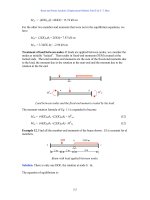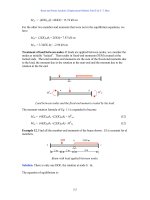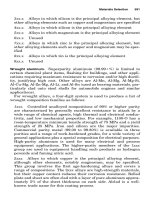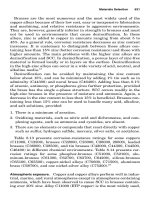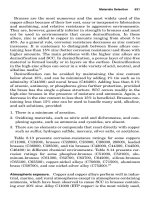Handbook Of Shaft Alignment Episode 2 Part 3 ppsx
Bạn đang xem bản rút gọn của tài liệu. Xem và tải ngay bản đầy đủ của tài liệu tại đây (1.22 MB, 30 trang )
You have to imagine that you are now looking at your drive system from above. When you
are looking at the drive system from the side view with the motor to your left and the pump to
your right, which way are you looking (north, south, east, or west)? Getting this direction
correct is very important because there is nothing worse than moving your machinery the
right amount in the wrong direction.
In our motor and pump drive system we are working on here, let us say that we are looking
toward the east as we view the machinery as shown in Figure 8.8 and Figure 8.9. Now that
we are going to be viewing our machines from above when modeling the top view, we want
to zero the indicator on the side that is pointing toward the top of the graph paper and plot
the reading that is on the side that is pointing toward the bottom of the graph paper. In this
case, the direction pointing toward the top of the graph paper in the top view is going to be
east. Therefore we want to zero the indicator on the east side of each shaft and plot the
reading we will obtain on the west side of each shaft.
There are two ways that we can do this. One way is to physically rotate the bracket and
indicator over to the east side of each shaft, zero the indicator there, and then rotate the bracket
and dial indicator 1808 over to the west side and record the dial indicator readings we get there.
The other way is to mathematically manipulate the east and west reading we obtained from the
complete set of dial indicator readings to zero the east sides. Figure 8.10 shows how to perform
this math on the east and west readings.
Original sag compensated readings
Motor
0
0
+30
−10
+20
−40
0+50 = +50
−50+50 = 0
+10+50 = +60
−40+50 = +10
0–30 = –30
+30−30 = 0
−10−30 = −40
+20−30 = −10
T
T
EW
B
E
T
T
EW
B
EW
B
T
T
E
W
B
E
E
E
W
W
W
B
W
B
+10−50
Pump
Motor
Motor
Motor
Pump
Pump
Pump
Sag
compensated
readings
Sag
compensated
readings
Sag
compensated
readings
Mathematcially zero the east readings
Original sag compensated readings with the east reading zeroed
−10
0
0
+60
−40
0
+60
−50
+10
0 −40
+30
East to west readings to be plotted in the top view
FIGURE 8.10 Zeroing the east readings.
Piotrowski / Shaft Alignment Handbook, Third Edition DK4322_C008 Final Proof page 330 6.10.2006 12:13am
330 Shaft Alignment Handbook, Third Edition
The original readings with the indicator zeroed on the top and the new readings with the
indicator zeroed on the east are telling us the same thing about the misalignment condition
between the two shafts. All we did was zero the indicator in a different position and notice
that the validity rule still applies whether we zero on top or on the east. Now that we are going
to be plotting the shafts in the top view, the top and bottom readings are meaningless, only
the east and west readings are important.
Figure 8.11 and Figure 8.12 show how to plot the east and west readings onto the top view
alignment model. Notice that the scale factor in the top view is not the same as the scale factor
in the side view. They do not have to be the same scale factor in both views but remember
what the scale factors are in each view. Without being too repetitive here, remember that you
only plot half of the dial indicator reading onto the graph. Also remember that whatever shaft
the dial indicator is taking readings on is the shaft that you want to draw on the graph paper.
Two of the major graphing mistakes people make are to forget to only plot half of the rim
reading and drawing the wrong shaft onto the graph.
The alignment models shown in Figure 8.9 through Figure 8.12 were generated using the
reverse indicator method, which is covered in more detail in Chapter 10. The other four alignment
Motor
Motor
Top view
East
Pump
Pump
20 mils
Scale:
5 in.
540 mils
Notice the scale
factor here.
Plot half (20 mils)
of this
measurement here.
0
E
W
−40
Pump
FIGURE 8.11 (See color insert following page 322.) Plotting the pump shaft in the top view.
Piotrowski / Shaft Alignment Handbook, Third Edition DK4322_C008 Final Proof page 331 6.10.2006 12:13am
Alignment Modeling Basics 331
methods (face–rim, double radial, shaft to coupling spool, and face–face) and their associated
graphing and modeling techniques will be discussed in Chapter 11 through Chapter 15.
8.4.6 DETERMINING CORRECTIVE MOVES TO MAKE ON ONE MACHINE FROM
THE
ALIGNMENT MODEL
Let us look at another example. Figure 8.13 shows a motor and a fan shaft misalignment
condition in the side view. As you can see, the shafts are not in alignment with each other.
Now what do we do? The next logical step is to determine the movement restrictions imposed
on the machine cases at the control or adjustment points (i.e., where the foot bolts are).
Movement restrictions define the boundary condition that help you to make an intelligent
decision on what alignment correction would be easy and trouble free to accomplish.
Trouble-free movement solutions? I fully understand that any corrective moves you make
on rotating machinery are not going to be trouble free and easy to make. But there are some
moves that will be far more difficult to make than others. You really need to have a wide
Motor
Motor
Pump
Pump
Top view
East
Plot half (30 mils)
of this
measurement here.
Motor
0
E
W
+60
Scale:
5 in.
20 mils
30 mils
FIGURE 8.12 (See color insert following page 322.) Plotting the motor shaft in the top view.
Piotrowski / Shaft Alignment Handbook, Third Edition DK4322_C008 Final Proof page 332 6.10.2006 12:13am
332 Shaft Alignment Handbook, Third Edition
variety of options to make the most effective and intelligent alignment correction. Therefore,
keep an open, objective mindset when you attempt to fix your alignment problem.
In Figure 8.13, notice that if you wanted to keep the fan in its current position, you would
have to move the motor downward at both the inboard and outboard ends. As shown in
Figure 8.13, the amount of movement at the outboard bolts is obtained by counting the
number of squares (at 3 mils per square with this scale factor) from where the actual motor
shaft centerline is at the outboard bolting plane to the extended centerline of rotation of the
fan. In this particular case, this is, 166 mils (0.166 in.). The amount of movement at the
inboard bolts is obtained by counting the number of squares from where the actual motor
shaft centerline is at the inboard bolting plane to the extended centerline of rotation of the
fan. In this case, that is, 66 mils (0.066 in.). If there is 166 mils under both outboard bolts and
66 mils under both inboard bolts (that are not soft foot shims) then a good alignment solution
would be to remove that amount of shim stock from under the appropriate feet. But what if
there are not that many shims under the inboard and outboard feet?
As bizarre as this may sound, I have seen people in a situation like this, remove the motor
from the baseplate and grind the baseplate away. Unbelievable, but true. And it is still done
somewhere today.
8.4.7 OVERLAY LINE OR FINAL DESIRED ALIGNMENT LINE
The final desired alignment line (a.k.a. the overlay line) is a straight line drawn on top of the
graph, showing the desired position both shafts should be in to achieve colinearity of
centerlines. It should be apparent that if one machine case is stationary, in this case the fan
shaft, that machine’s centerline of rotation is the final desired alignment line as shown in
Figure 8.13.
There is another way to correct the misalignment problem on this motor and fan that will
be far less troublesome. Since adjustments are made at the inboard and outboard feet of the
machinery, some logical alternative solutions would be to consider using one or more of these
feet as pivot points. Both outboard feet or both inboard feet, or the outboard foot of one
machine case and the inboard foot of the other machine case could be used as pivot points. By
Up
Motor
Side view
Fan
Motor shaft centerline
66 mils down
166 mils down
Scale:
5 in.
30 mils
Fan shaft
centerline
FIGURE 8.13 Movement solutions for the motor only.
Piotrowski / Shaft Alignment Handbook, Third Edition DK4322_C008 Final Proof page 333 6.10.2006 12:13am
Alignment Modeling Basics 333
drawing the overlay line through these foot points, shaft alignment can usually be achieved
with smaller moves. In real life situations, you will typically have greater success aligning two
machine cases a little bit rather than moving one machine case a lot. Figure 8.14 shows using
the overlay line to connect the outboard bolting plane of the motor with the outboard bolting
plane of the fan. The inboard bolting planes are then moved the amount shown in Figure 8.14
to correct the misalignment condition in the up and down direction. No shims had to be
removed and better yet, no baseplates had to be ground away.
8.4.8 SUPERIMPOSE YOUR BOUNDARY CONDITIONS,MOVEMENT RESTRICTIONS, AND
ALLOWABLE MOVEMENT ENVELOPE
When viewing the machinery in the up and down direction (side view), the movement
restrictions are defined by the amount of movement the machinery can be adjusted in the
up and down directions.
How far can machinery casings be moved upward? There is virtually an unlimited amount
of movement in the up direction, within reason, that is. Machine cases are typically moved
upward by installing shims (i.e., sheet metal of various thicknesses) between the undersides of
the machinery feet and the baseplate.
How far can the machinery casings be moved downward? Well, it depends on the amount
of shim stock currently under the machinery feet that are not soft foot corrections.
How far can you move a machine down? I don’t know. You are going to have to look
under the machine to see how much shim stock could be removed from under the machinery
feet on every machine in the drive system. Maybe there are 10, 20, or 50 mils of shim stock
under the machinery feet that can be removed that are not soft foot corrections that could be
taken out. You will have to see what is there. These shims define the ‘‘downward movement
envelope,’’ or as some people call it, the ‘‘basement floor,’’ or as other people call it, the
‘‘baseplate restriction point.’’
Shim stock typically refers to sheet metal thicknesses ranging from 1 mils (0.001 in.) to 125
mils (0.125 in.). There are several companies that manufacture precut, U-shaped shim stock in
Up
Side view
Raise 48 mils up
Overlay line
Motor
Pivot here
Motor shaft
centerline
Scale:
5 in.
30 mils
Raise 138 mils up
Fan
Pivot here
Fan shaft
centerline
FIGURE 8.14 (See color insert following page 322.) Movement solutions for the inboard feet of both the
motor and the pump by pivoting at the outboard feet of both machines.
Piotrowski / Shaft Alignment Handbook, Third Edition DK4322_C008 Final Proof page 334 6.10.2006 12:13am
334 Shaft Alignment Handbook, Third Edition
4 standard sizes and 17 standard thicknesses. Once shim thicknesses get over 125 mils, they
are typically referred to as spacers or plates and are custom made from plate steel.
So if you want to move a machine downward and there are no shims under the machinery
feet, you are already on the basement floor and that is defined as a downward vertical
movement restriction or a baseplate restriction point. Figure 8.15 shows the same motor
and fan but now we have observed that there are 75 mils of shim stock under the outboard
feet and 25 mils of shims under the inboard feet that are not soft foot corrections that could be
removed if we wanted to. By counting down 75 mils from the centerline of the motor shaft
and the outboard bolting plane and drawing a baseplate restriction point there, we can now
see how far that end can come down without removing metal from the baseplate or machine
casing. Similarly, by counting down 25 mils from the centerline of the motor shaft and the
inboard bolting plane and drawing a baseplate restriction point there, we can now see how far
that end can come down without removing metal. In this particular case, there were no shims
under any of the feet of the fan so its baseplate restriction points are positioned directly on the
fan centerline at the inboard and outboard ends as shown in Figure 8.15. Now that we know
what the lowest points of downward movement could be without removing metal, one
possible solution would be to use the outboard feet of the fan and the inboard feet of the
motor as pivot points removing 72 mils of shims from under the outboard feet of the motor
and installing 42 mils of shims under the inboard feet of the fan as shown in Figure 8.15.
8.4.8.1 Lateral Movement Restrictions
In addition to aligning machinery in the up and down direction, it is also imperative that the
machinery be aligned properly side to side. Machinery is aligned side to side by translating the
machine case laterally. This sideways movement is typically monitored by setting up dial
indicators along the side of the machine case at the inboard and outboard hold down bolts,
anchoring the indicators to the frame or baseplate, zeroing the indicators, and then moving
the inboard and outboard ends the prescribed amounts. Here is where realignment typically
becomes extremely frustrating since there is a limited amount of room between the shanks of
the hold down bolts and the holes drilled in the machine case feet.
Up
Side view
Overlay line
Motor
Pivot here
Lower 72 mils
down
75 mils of
shims
available to
remove
25 mils of
shims
available to
remove
Scale:
5 in.
30 mils
Baseplate restriction points
Raise 42 mils up
Fan
pivot here
No shims
available to
remove
Fan shaft
centerline
No shims
available to
remove
FIGURE 8.15 (See color insert following page 322.) Movement solutions using the outboard feet of the
fan and the inboard feet of the motor as pivot points.
Piotrowski / Shaft Alignment Handbook, Third Edition DK4322_C008 Final Proof page 335 6.10.2006 12:13am
Alignment Modeling Basics 335
If, for example, you wanted to move the outboard end of a machine 120 mils to the south,
began moving the outboard end monitoring the move with a dial indicator, and the machine
case stopped moving after 50 mils of translation, this would be considered a movement
restriction commonly referred to as a ‘‘bolt bound’’ condition. The problem in moving
machinery laterally is that there is a limited amount of allowable movement in either
direction. The total amount of side-to-side movement at each end of the machine case is
referred to as the ‘‘lateral movement envelope.’’ To find the allowable lateral movement
envelope, remove a bolt from each end of the machine case, look down the hole, and see how
much room exists between the shank of the bolt and the hole drilled in the machine case at
that foot. If necessary, thread the bolt into the hole a couple of turns, and measure the gaps
between the bolt shank and the sides of the hole with feeler or wire gauges.
It is very important for one to recognize that trouble free alignment corrections can only be
achieved when the allowable movement envelope is known. Perhaps one of the most import-
ant statements that will be made in this chapter is
When you consider that both machine cases are movable, there are an infinite number of possible
ways to align the shafts, some of which fall within the allowable movement envelope.
It seems ridiculous, but many people have ground baseplates or the undersides of machin-
ery feet away because they felt that a machine had to be lowered. When machinery becomes
bolt bound when trying to move it sideways, people frequently cut down the shanks of the
bolts or grind a hole open more.
There is typically an easier solution. Disappointingly, many of the alignment measurement
systems shown in this book force the user to name one machine case stationary and the other one
movable which will invariably cause repositioning problems when the machine case has to be
moved outside its allowable movement envelope. This may not happen the first time you align a
drive system, or the second or third time, but if you align enough machinery, eventually you will
not be able to move the movable machine the amount prescribed. Once the centerlines of rotation
have been determined and the allowable movement envelope illustrated on the graph, it becomes
very apparent what repositioning moves will work easily and which ones will not.
Figure 8.16 shows the top view alignment model of a motor and pump. Not knowing any
better, it appears that all you would have to do is move the outboard end of the motor 14 mils
to the east and the inboard end of the motor 4 mils to the west. Easy enough. But what if the
outboard end of the motor is bolt bound to the east already?
By removing one bolt from the inboard and outboard ends of both the motor and pump,
the lateral movement restrictions can be observed. In this case the following restrictions were
observed:
1. Outboard end of motor—bolt bound to east and 40 mils of possible movement to the
west
2. Inboard end of motor—bolt bound to east and 40 mils of possible movement to the west
3. Inboard end of pump—32 mils of possible movement to the east and 8 mils of possible
movement to the west
4. Outboard end of pump—36 mils of possible movement to the east and 4 mils of possible
movement to the west
By plotting the eastbound and westbound restriction onto the alignment model, you can
now see the easy corridor of movement. One possible solution (out of many) is shown in
Figure 8.16.
Piotrowski / Shaft Alignment Handbook, Third Edition DK4322_C008 Final Proof page 336 6.10.2006 12:13am
336 Shaft Alignment Handbook, Third Edition
Please, for your own sake, follow these four basic steps to prevent you from wasting hours
or days of your time correcting a misalignment condition:
1. Find the positions of every shaft in the drive train by the graphing and modeling
techniques shown in this and later chapters.
2. Determine the total allowable movement envelope of all the machine cases in both
directions.
3. Plot the restrictions on the graph or model.
4. Select a final desired alignment line or overlay line that fits within the allowable
movement envelope (hopefully) and move the machinery to that line.
If you are involved with aligning machinery, by following the four steps above, it is
guaranteed that you will save countless hours of wasted time trying to move one machine
where it does not really want to go.
8.4.8.2 Where Did the Stationary–Movable Alignment Concept Come From?
I don’t know. Every piece of rotating machinery in existence has, at one time or another, been
placed there. Mother Earth never gave birth to a machine. They are neither part of the Earth’s
mantle nor firmly imbedded in bedrock. Every machine is movable, it is just a matter of effort
(pain) to reposition it. So why have the vast majority of people who align machinery called
one machine stationary and the other machine movable?
The only viable reason that I can come up with is this—in virtually every industry there is
an electric motor driving a pump. When you first approach a motor pump arrangement, you
immediately notice that the pump has piping attached to it and the only appendage attached
to the motor is conduit (usually flexible conduit). From your limited vantage point at this
time it would appear to be easier to move the motor because there is no piping attached to it
like the pump. You would prefer to just move the motor because it looks easier to move than
the pump (and so would I). The assumption is made that the pump will not be moved, no
matter what position you find the motor shaft in with respect to the pump shaft.
Motor
Top view
32 mils of
possible
movements to
the east here
Pivot here
Pump
36 mils of
possible
movement to
the east here
Move 14 mils
east here
4 mils of
possible
movement
to the west
here
8 mils of
possible
movement
to the west
here
Lateral movement restriction points
40 mils of
possible
movement
to the west here
20 mils
5 in.
Scale:
Move 20 mils
west here
East boundary line
West boundary line
Move 22 mils
west here
Bolt bound
to east
here
East
FIGURE 8.16 (See color insert following page 322.) Applying lateral movement restrictions to arrive at
an easy sideways move within the east and west corridors.
Piotrowski / Shaft Alignment Handbook, Third Edition DK4322_C008 Final Proof page 337 6.10.2006 12:13am
Alignment Modeling Basics 337
But what do you do when you have to align a steam turbine driving a pump? They are both
piped; which machine do you call the stationary machine—the pump or the turbine? No
matter what your answer is, you are going to have to move one of them and they both have
piping attached to their casings.
Piping is no excuse not to move a piece of machinery, particularly in light of what most of
us know about how piping is really attached to machinery. For some people, they are afraid
to loosen the bolts holding a machinery with piping attached to it because the piping strain is
so severe that they fear the machine will shift so far that it will never get back into alignment.
So is the problem with the alignment process or the piping fit-up? Refer to Chapter 3 for
information on this subject.
If you align enough machinery and insist that one machine will be stationary, eventually
you will get exactly what you deserve for your shallow range of thinking.
8.4.8.3 Solving Piping Fit-Up Problems with the Overlay Line
Although we have been showing that the overlay line (a.k.a. final desired alignment line) is
drawn through foot bolt points, it is important to see that the overlay line could be drawn
anywhere and the machinery shafts moved to that line.
This can be particularly beneficial if there are other considerations that have to be taken
into account such as piping fit-up problems. Figure 8.17 shows a motor and pump where the
suction pipe is 1=4 in. higher than the suction flange on the pump and there is a 1=4 in.
excessive gap at the discharge flanges. Rather than align both shafts, then install an additional
0.250Љ
Motor
Pump
15Љ
Motor Pump
Side view
15Љ 5.5Љ
Bracket clamping positions
Scale:
Suction flange location
7Љ 14.5Љ10Љ
5.5Љ 7Љ 14.5Љ 5Љ
10.25Љ
1Љ 1Љ
0.250Љ
5 in.
FIGURE 8.17 (See color insert following page 322.) Scaling off the dimensions for a motor and pump
including the location of the suction flange on the pump.
Piotrowski / Shaft Alignment Handbook, Third Edition DK4322_C008 Final Proof page 338 6.10.2006 12:13am
338 Shaft Alignment Handbook, Third Edition
250 mils (1=4 in.) under all the feet, another easier solution exists. Scale off where the suction
flange of the pump is onto the alignment model. Extend the centerline of the pump to go out
to the suction flange point. Place a mark 250 mils above the pump shaft centerline where the
suction flange is located. Construct an overlay line to go from that point to the outboard bolts
of the motor as illustrated in Figure 8.18. Then solve for the moves at each bolting plane not
only to eliminate the piping fit-up problem but also to align the shafts.
We have reviewed many of the basic concepts behind alignment modeling in this chapter.
Determining your maximum misalignment deviation and whether you are within acceptable
alignment tolerances will be covered in the next chapter. Specific instruction on how to
perform all five-alignment measurement methods and their associated modeling techniques
will be covered in Chapter 10 through Chapter 15.
BIBLIOGRAPHY
Dodd, V.R., Total Alignment, Petroleum Publishing Company, Tulsa, OK, 1975.
Dreymala, J., Factors Affecting and Procedures of Shaft Alignment, Technical and Vocational Depart-
ment, Lee College, Baytown, TX, 1970.
Piotrowski, J., Basic Shaft Alignment Workbook, Turvac Inc., Cincinnati, OH, 1991.
Suction flange moves up
250 mils at this point
Pivot here
Raise 47 mils up
Scale:
5 mils
Motor
0
T
B
E
W
T
B
E
W
−60
+10 +90
+80
0
−
10
Sag
compensated
readin
g
s
−70
Pump
Up
Side view
Raise 170 mils up
Raise 235 mils up
5 in.
FIGURE 8.18 (See color insert following page 322.) Overlay line positioned to correct the piping fit-up
problem and align the shafts with one move.
Piotrowski / Shaft Alignment Handbook, Third Edition DK4322_C008 Final Proof page 339 6.10.2006 12:13am
Alignment Modeling Basics 339
Piotrowski / Shaft Alignment Handbook, Third Edition DK4322_C008 Final Proof page 340 6.10.2006 12:13am
9
Defining Misalignment:
Alignment and Coupling
Tolerances
9.1 WHAT EXACTLY IS SHAFT ALIGNMENT?
In very broad terms, shaft misalignment occurs when the centerlines of rotation of two (or
more) machinery shafts are not in line with each other. Therefore, in its purest definition,
shaft alignment occurs when the centerlines of rotation of two (or more) shafts are collinear
when operating at normal conditions. As simple as that may sound, there still exists a
considerable amount of confusion to people who are just beginning to study this subject
when trying to precisely define the amount of misalignment that may exist between two shafts
flexibly or rigidly coupled together.
How do you measure misalignment when there are so many different coupling designs?
Where should the misalignment be measured? Is it measured in terms of mils, degrees,
millimeters of offset, arcseconds, radians? How accurate does the alignment have to be?
When should the alignment be measured, when the machines are off-line or when they are
running? Perhaps a commonly asked question needs to be addressed first.
9.2 DOES LEVEL AND ALIGNED MEAN THE SAME THING?
The level and aligned does not mean the same thing. The term ‘‘level’’ is related to Earth’s
gravitational pull. When an object is in a horizontal state or condition or points along the
length of the centerline of an object are at the same altitude, the object is considered to be
level. Another way of stating this is that an object is level if the surface of the object is
perpendicular to the lines of gravitational force. A level rotating machinery foundation
located in Boston would not be parallel to a level rotating machinery foundation located in
San Francisco as the Earth’s surface is curved. The average diameter of the Earth is 7908.5
miles (7922 miles at the equator and 7895 miles at the poles due to the centrifugal force
causing the planet to bulge at the center). When measuring the distances of arc across the
Earth’s surface, 18 of arc is slightly over 69 miles, 1 min of arc is slightly over 1.15 miles, and
one second of arc is slightly over 101.2 ft.
It is possible, although rare, to have a machinery drive train both level and aligned. It is
also possible to have a machinery drive train level but not aligned and it is also possible to
have a machinery drive train aligned but not level. As shaft alignment deals specifically with
the centerlines of rotation of machinery shafts it is possible to have, or not to have, the
centerlines of rotation perpendicular to the lines of gravitational force.
Historically, there were a considerable number of patents filed from 1900 to 1950 that
seemed to combine (or maybe confuse) the concept of level and aligned. A number of these
Piotrowski / Shaft Alignment Handbook, Third Edition DK4322_C009 Final Proof page 341 26.9.2006 8:42pm
341
alignment devices were used in the paper industry where extremely long ‘‘line shafts’’ were
installed to drive different parts of a paper machine. These line shafts were constructed with
numerous sections of shafting that were connected end to end with rigid couplings and
supported by a number of bearing pedestals along the length of the drive system, which
could be 300 ft in length or more. Even if a mechanic carefully aligned each section of shafting
at each rigid coupling connection along the length of the line shaft and perfectly leveled each
shaft section, the centerline of rotation at each end of a 300-ft long line shaft would be out by
0.018 in. due to the curvature of the Earth’s surface.
Although level and aligned may not mean the same thing, proper leveling is important as well
as having coplanar surfaces. Levelness refers to a line or surface, which is perpendicular to
gravity; coplanar surface refers to ‘‘flatness.’’ Are the points where the machinery cases contact
the baseplate (or soleplates) in the same plane? If not, how much of a deviation is there?
It is very common to see baseplates where the machinery contact surfaces are not in the same
plane or several soleplates that contact a single machine case not be in the same plane. This
coplanar deviation may be a contributor to a condition commonly referred to as a ‘‘soft foot’’
problem and was covered in Chapter 5. Figure 9.1 shows the recommended guidelines for leveling
machinery baseplates and coplanar surface deviation. As will be seen, even if the surfaces of a
baseplate are perfectly level and perfectly coplanar, a soft foot condition could still exist.
9.3 MEASURING ANGLES
Angular misalignment is shown in Figure 9.2. As the term ‘‘angular’’ or ‘‘angle’’ is used, it is
necessary to briefly describe how angles are measured.
There are 3608 in a circle. Each degree can be divided into 60 parts called minutes of arc and
each minute of arc can be further divided into 60 parts called seconds of arc. Therefore there
are 21,600 min of arc and 1,296,000 s of arc in a circle.
General process
machinery supported
in antifriction bearings
10 mils per foot 10 mils
General process
machinery supported
in sleeve bearings
(up to 500 hp)
5 mils per foot
Process machinery
supported in
antifriction bearings
(500+ hp)
5 mils per foot
Process machinery
supported in sleeve
bearings (500+ hp)
2 mils per foot
Machine tools
1 mil per foot
Note: 1 mil = 0.001 in.
5 mils
5 mils
5 mils
2 mils
Machinery Type
Minimum
Recommended
Levelness
Coplanar
Surface
Deviation
FIGURE 9.1 Recommended levelness and coplanar surface deviation for rotating machinery baseplates
or soleplates.
Piotrowski / Shaft Alignment Handbook, Third Edition DK4322_C009 Final Proof page 342 26.9.2006 8:42pm
342 Shaft Alignment Handbook, Third Edition
Another way of expressing circles is by use of radians. All circles are mathematically related
by an irrational number called pi (p), which is approximately equal to 3.14159. There are 2p
radians in a circle. Therefore one radian is equal to 57.2958288.
Despite the fact that the expression ‘‘angular misalignment’’ is used frequently it comes as a
surprise to learn that no known shaft alignment measurement system actually uses an angular
measurement sensor or device.
9.4 TYPES OF MISALIGNMENT
Shaft misalignment can occur in two basic ways: parallel and angular as shown in Figure 9.2.
Actual field conditions usually have a combination of both parallel and angular misalignment
so measuring the relationship of the shafts gets to be a little complicated in a three-
dimensional world especially when you try to show this relationship on a two-dimensional
piece of paper. I find it helpful at times to take a pencil in each hand and position them based
on the dial indicator readings to reflect how the shafts of each unit are sitting.
9.5 DEFINITION OF SHAFT MISALIGNMENT
In more precise terms, shaft misalignment is the deviation of relative shaft position from a
collinear axis of rotation measured at the flexing points in the coupling when equipment is
running at normal operating conditions. To better understand this definition, let us dissect
each part of this statement to clearly illustrate what is involved.
Parallel misalignment
Angular misalignment
“Real world” misalignment usually
exhibits a combination of both
parallel and angular conditions
FIGURE 9.2 How shafts can be misaligned.
Piotrowski / Shaft Alignment Handbook, Third Edition DK4322_C009 Final Proof page 343 26.9.2006 8:42pm
Defining Misalignment: Alignment and Coupling Tolerances 343
Collinear means in the same line or in the same axis. If two shafts are collinear, then they
are aligned. The deviation of relative shaft position accounts for the measured difference
between the actual centerline of rotation of one shaft and the projected centerline of rotation
of the other shaft.
There are literally dozens of different types of couplings. Rather than have guidelines for
each individual coupling, it is important to understand that there is one common design
parameter that applies to all flexible couplings:
For a flexible coupling to accept both parallel and angular misalignment there must be at least two
points along the projected shaft axes where the coupling can flex or articulate to accommodate the
misalignment condition.
The rotational power from one shaft is transferred over to another shaft through these
flexing points. These flexing points are also referred to as flexing planes or points of power
transmission. Shaft alignment accuracy should be independent of the type of coupling used
and should be expressed as a function of the shaft positions, not the coupling design or the
mechanical flexing limits of the coupling. Figure 9.3 illustrates where the flexing points in a
variety of different coupling designs are located. I have seen several instances where there is
only one flexing point in the coupling and have also seen more than two flexing points in the
coupling connecting two shafts together. If only one flexing point is present and there is an
offset between the shafts or a combination of an angle and an offset, there will be some very
high radial forces transmitted across the coupling into the bearings of the two machines. If
there are more than two flexing points, there will be a considerable amount of uncontrolled
motion in between the two connected shafts, usually resulting in very high vibration levels in
the machinery.
Why should misalignment be measured at the flexing points in the coupling? Simply
because that is where the coupling is forced to accommodate the misalignment condition
and that is where the action, wear, and power transfer across the coupling is occurring.
Flex points
Flex points
Flex points
Flex points
Flex points
Flex points
FIGURE 9.3 Flexing point locations in a variety of couplings.
Piotrowski / Shaft Alignment Handbook, Third Edition DK4322_C009 Final Proof page 344 26.9.2006 8:42pm
344 Shaft Alignment Handbook, Third Edition
Figure 9.4 shows a typical misalignment situation on a motor and a pump. By projecting the
axis of rotation of the motor shaft toward the pump shaft (and conversely the pump shaft
rotational axis toward the motor shaft) there is a measurable deviation between the projected
axes of rotation of each shaft and the actual shaft centerlines of each shaft where the power is
transmitted through the coupling from one flexing point to another. As we measure misalign-
ment in two different planes (vertical and horizontal) there will be four deviations that occur at
each flexible coupling as shown in Figure 9.5. In a horizontally mounted drive train, two of these
deviations occur in the top view describing the amount of lateral (side to side) misalignment.
Two more deviations occur when viewing the drive train in the side view, which describes the
vertical (up and down) misalignment. The goal of the person doing the alignment is to position
the machinery casings such that all of these deviations are below certain tolerance values.
Therefore, there are three factors that affect alignment tolerances of rotating machinery—
the speed of the drive train, the maximum deviation at either flexing point or point of power
transmission and power reception, and the distance between the flexing points or points of
power transmission.
The last part of the definition of shaft misalignment is probably the toughest to achieve and
usually the one aspect of alignment that is most often ignored. When rotating equipment is
started, the shafts will begin to move to another position. The most common cause of this
movement is due to temperature changes that occur in the machinery casings and therefore
this movement is commonly referred to as hot and cold alignment. These temperature
changes are caused by friction in the bearings or by thermal changes that occur in the process
liquids and gases. Movement of machinery may also be caused by process reaction moments
Misalignment is the deviation of relative shaft
position from a colinear axis of rotation measured
at the points of power transmission when equipment
is running at normal operating conditions
Driver offset
(in mils)
Driven offset
(in mils)
Maximum alignment
deviation occurs here
Driver shaft
Driven shaft
FIGURE 9.4 Definition of shaft misalignment.
Piotrowski / Shaft Alignment Handbook, Third Edition DK4322_C009 Final Proof page 345 26.9.2006 8:42pm
Defining Misalignment: Alignment and Coupling Tolerances 345
in attached piping or counterreactions due to the rotation of the rotor, something similar to
the forces you feel when you try to move your arm around with a spinning gyroscope in your
hand. Chapter 16 covers this topic in great detail.
Throughout this book misalignment conditions will be specified in mils offset occurring at
each point of power transmission, with particular attention being paid to the maximum offset
that occurs at either transmission point as determined in Figure 9.5. Figure 9.6 shows a
go=no-go guide for acceptable shaft alignment of flexibly connected rotating machinery.
Notice that all three factors mentioned above are incorporated in the Misalignment Tolerance
Guide. The speed of the machine (in thousands of rpm) is shown on the X-axis of the graph.
On the Y-axis of the graph, the distance between power transmission points (in inches or
meters) and the maximum offset (in mils or millimeters) is expressed as a ratio (mils=inch or
millimeters=meter).
Side
view
Top
view
Find the largest of the four deviations or gaps between the
centerlines of rotation of both shafts at each point of power
transmission (aka. the coupling “flex points”) and then divide
the largest deviation by the distance between these points
These two deviations dictate the alignment accuracy
of the two shafts in the side-to-side direction
These two deviations dictate
the alignment accuracy of
the two shafts in the up and
down direction
Points of power transmission or
“flex points” in the coupling
Here is the distance between the points
of power transmission (flex points)
For example:
If the maximum deviation of all four
points is 6 mils, and the distance between
the “flex points” is 4 in. then
6 mils
4 in.
= 1.5 mils/in.
is your maximum
misalignment deviation
Here is the largest of the
four deviations
Centerlines of rotation
of each shaft
Remember, for a
flexible coupling to
accomodate both
parallel and angular
misalignment, it must
have two flexing points
FIGURE 9.5 How to find the maximum misalignment deviation?
Piotrowski / Shaft Alignment Handbook, Third Edition DK4322_C009 Final Proof page 346 26.9.2006 8:42pm
346 Shaft Alignment Handbook, Third Edition
9.6 CHECKING THE MISALIGNMENT TOLERANCE
The alignment modeling techniques shown in Chapter 8 enable us to visually represent the
relative positions of the centerlines of rotation of the two shafts. Once the positions of the
shafts have been determined, the first step is to determine whether the amount of misalign-
ment is within tolerance or not.
At any point in time, the machinery shafts are somewhat misaligned side to side and
misaligned up and down (or any other coordinates they happen to lie in). The key is to find
the largest of the four deviations at the points of power transmission (the flexing points) and
divide it by the distance between points of power transmission (the flexing points). Two of
these deviations occur in the top view, which will show the amount of lateral (side to side)
misalignment, two more deviations occur in the side view, which show the amount of vertical
(up=down) misalignment as illustrated in Figure 9.7 and Figure 9.8.
The side view in Figure 9.7 shows a 30 mil deviation at the coupling flex point by the motor
and a 15 mil deviation at the coupling flex point by the fan. The top view in Figure 9.8 shows an
18 mil deviation at the coupling flex point by the motor and a 6 mil deviation at the coupling flex
point by the fan. Of those four deviations, 30, 15, 18, and 6 mils, the largest deviation is 30 mils.
The distance between the flexing points in the coupling is 6.5 in. To determine your maximum
misalignment deviation, find the largest of the four deviations, in this case 30 mils, and divide it
by the distance between the flexing points in the coupling, in this case 6.5 in. 30 mils divided by
6.5 in. is 4.6 mils per inch. If you refer to the Alignment Tolerance Guide (Figure 9.6) you can see
that 4.6 mils=in. is not within acceptable alignment tolerances at any shaft speed. Therefore,
you have to improve the alignment between those two machines.
The maximum misalignment deviation can be determined directly from the graph. Note
that the flexing points do not necessarily occur at the same points where the readings were
taken. However, as the misalignment is expressed in mils per inch, whether the deviations are
measured where the readings were taken, or at the ends of the shafts, or at the flexing points
10 122468 14161820222426
0.5
1.0
1.5
2.0
Maximum deviation at
either point of power transmission
Mils per inch
Speed (RPM ϫ 1000)
Misalignment tolerance guide
Angle
degrees
0.10
0.08
0.06
0.04
0.02
R
e
a
l
i
g
n
m
e
n
t
n
e
c
e
s
s
a
r
y
A
c
c
e
p
t
a
b
l
e
Excellent
FIGURE 9.6 (See color insert following page 322.) Recommended maximum misalignment of flexibly
connected rotating machinery.
Piotrowski / Shaft Alignment Handbook, Third Edition DK4322_C009 Final Proof page 347 26.9.2006 8:42pm
Defining Misalignment: Alignment and Coupling Tolerances 347
themselves, the misalignment deviation (remember, it is in mils=inch) will always be the same
amount (i.e., the deviation might be different at each of the points around the coupling area
but so is the distance between them).
9.7 SHAFT VERSUS COUPLING ALIGNMENT
Frequently people use the terms ‘‘shaft alignment’’ and ‘‘coupling alignment’’ interchange-
ably. Is there really a difference?
Yes, shaft alignment and coupling alignment do not necessarily mean the same thing.
Coupling tolerances typically define the maximum misalignment limit of the flexible coupling.
Up
Side view
Scale:
5 in. 30 mils
Motor Fan
Flexing points or points of
power transmission
30 mils
15 mils
6.5"
Motor shaft
centerline
Fan shaft
centerline
FIGURE 9.7 Misalignment deviations in the side view.
Scale:
Top view
5 in. 30 mils
Motor Fan
West
Flexing points or points of
power transmission
18 mils
6 mils
Motor shaft
centerline
Fan shaft
centerline
FIGURE 9.8 Misalignment deviations in the top view.
Piotrowski / Shaft Alignment Handbook, Third Edition DK4322_C009 Final Proof page 348 26.9.2006 8:42pm
348 Shaft Alignment Handbook, Third Edition
In other words, at what point will the coupling ‘‘lock up’’ and stop working or begin to
sustain rapid deterioration in the coupling. It is not uncommon to see 1=8 in. or more
allowable offset advertised by a coupling manufacturer. The coupling may be able to accept
this amount of misalignment but can the machinery shafts, bearings, and seals accept this for
long periods of time?
There may be other problems with the coupling that can confuse the person performing an
alignment job. Notice in Figure 9.9 that the centerline of rotation of the shaft on the left is in
line with the centerline of the bore of the coupling hub on the shaft on the right but it is not
in line with the centerline of rotation of the shaft on the right.
By its purest definition, shaft alignment occurs when the centerlines of rotation are collinear.
This is a very important point in aligning rotating machinery that a vast number of people
overlook. It is possible to align the centerlines of rotation of machinery shafts that are bent or that
have improperly bored coupling hubs and never know that these eccentricity problems exist.
These eccentricities are referred to as runout problems and were discussed in Chapter 5. From the
inboard bearing out to the end of the shaft there are three basic types of eccentricity problems that
can occur: a coupling hub whose hole was bored off center or overbored and drawn off center
with the set screw, a skew (angle) bored hole in the coupling hub, or a bent shaft.
Notice in Figure 9.10 that when a bent shaft is rotated, its centerline of rotation is straight
but the shaft itself is not. In this situation what should we try to align the shaft on the right to?
The centerline of the bore of the coupling hub at the end of the shaft or the centerline of
rotation itself ? The correct answer should be: you should never try to align a piece of
machinery that has a bent shaft or an improperly bored coupling hub.
9.8 HOW STRAIGHT ARE ROTATING MACHINERY SHAFTS?
The assumption that many people make is that the centerlines of rotation of machinery
operate in a perfectly straight line. In vertically oriented shafts this may indeed be true but
the vast majority of rotating machinery has shafts that are horizontally mounted and the
weight of the shaft and the components attached to the shaft cause the shaft to bow from its
own weight. This naturally occurring curvature of a machinery rotor is often referred to as a
catenary curve.
Centerline of rotation Centerline of rotation and
centerline of coupling hub bore
Centerline of coupling
hub outer perimiter
If you rotate this shaft only,
you will align the centerline
of rotation with the
centerline of the
improperly bored coupling
hub, not the other shaft
centerline of rotation
To align the centerlines of rotation
(true shaft alignment) both shafts
should be rotated together if a runout
condition exists on either or both shafts.
If no runout exists (on the shaft you
are measuring), then the shafts do
not have to be rotated together
0
50
10
40
20
30
+
_
10
40
20
30
FIGURE 9.9 Aligning a centerline of rotation to the center of an improperly bored coupling.
Piotrowski / Shaft Alignment Handbook, Third Edition DK4322_C009 Final Proof page 349 26.9.2006 8:42pm
Defining Misalignment: Alignment and Coupling Tolerances 349
Definitions:
Catenary—the parabolic curve assumed by a perfectly flexible inextensible cord of uniform
density and cross section suspended from two fixed points.
Catenoid—the surface described by the rotation of a catenary about its axis.
Figure 9.11 shows an exaggerated view of the naturally occurring curvature of center
mounted and overhung shafts.
The amount of deflection depends on several factors such as the stiffness of the shaft, the
amount of weight between support points, the bearing design, and the distance between
support points. For the vast majority of rotating machinery in existence, this catenary bow
is negligible and for all practical purposes is ignored. On extremely long drive trains however
(e.g., turbine generators in power generating plants and motor-generator sets), this catenary
curve must be taken into consideration. Figure 9.12 shows the ideal catenary curve for a 1200
MW turbine generator unit. Notice that the difference in elevation between bearings 5 or 6
compared to bearing 10 is 1.25 in.
When a very long, flexible shaft begins to rotate, the bow tries to straighten out but will
never become a perfect straight line. It is important to understand that the axis of rotation of
a shaft could very possibly operate on a curved axis of rotation. In situations where two or
more pieces of machinery are coupled together where one or more of the shafts are rotating
around a catenary-shaped axis of rotation, it is important to align the shafts so they maintain
the curved centerline of rotation.
Centerline of rotation
of bent shaft
Centerline of bore
of coupling hub
Where should this
shaft be placed?
?
FIGURE 9.10 Problems aligning a straight shaft to a bent one.
Piotrowski / Shaft Alignment Handbook, Third Edition DK4322_C009 Final Proof page 350 26.9.2006 8:42pm
350 Shaft Alignment Handbook, Third Edition
FIGURE 9.11 Natural elastic bending of horizontally mounted shafts.
Piotrowski / Shaft Alignment Handbook, Third Edition DK4322_C009 Final Proof page 351 26.9.2006 8:42pm
Defining Misalignment: Alignment and Coupling Tolerances 351
100 in.
Scale:
100 mils
Exciter Generator LPC Turbine
LPB Turbine LPA Turbine HP Turbine
up
looking east
Zero elevation line
Side view
11 10
9
7
5 4
2
1
0.100
0.200
0.300
0.400
0.500
0.600
0.700
0.800
0.900
1.000
1.100
1.200
0
0.100
0.200
0.300
0.400
0.500
0.600
0.700
0.800
0.900
1.000
1.100
1.200
0
Best fit catenary curve
3
86
FIGURE 9.12
Catenary curve of a turbine-generator drive system.
Piotrowski / Shaft Alignment Handbook, Third Edition DK4322_C009 Final Proof page 352 26.9.2006 8:42pm
352 Shaft Alignment Handbook, Third Edition
10
Reverse Indicator Method
The reverse indicator method is also often called the indicator reverse method or the double
dial method and is shown in Figure 10.1. This method seems to have originated around the
mid to late 1950s in the United States and it is not clear who first developed this technique.
Clark brothers (now Dresser–Rand) adopted this technique for use in aligning their rotating
machinery and Don Cutler (currently working for Thomas-Rexnord) developed the line-to-
point graphing method while working for Clark.
The reverse indicator method can be used on 60%–70% of the rotating machinery in
existence and is still one of the preferred dial indicator methods for measuring rotating
machinery shafts. It is best suited for use when the distances between measuring points on
each shaft range from 3 to 30 in. Although Figure 10.1 shows using two brackets and two dial
indicators at the same time, there is no reason why one bracket and dial indicator setup could
not be used where a set of readings are captured on one shaft first and then reversing the
bracket and indicator to capture a set of readings on the other shaft. In fact, it may be wise to
use just one bracket at a time to insure that readings are taken correctly and minimize the
confusion that could result from trying to observe two indicators simultaneously as illustrated
in Figure 10.2. Additionally, how much time does it take to setup two brackets and two
indicators versus setting up one bracket and one indicator twice?
Advantages
.
Typically more accurate than the face-rim method as the distance from the mounting
point of the bracket to the point where the indicators capture the readings on the shafts is
usually greater than the distance a face reading can be taken.
.
If the machinery is supported in sliding type bearings and the shafts are floating back or
forth axially when rotating the shaft-to-capture readings, there is virtually no effect on
the accuracy of the readings.
Disadvantages
.
Both shafts must be rotated.
.
Difficult to visualize the positions of the shafts from the dial indicator readings.
.
Bracket sag must be measured and compensated for.
10.1 BASIC MATHEMATICAL EQUATIONS FOR THE REVERSE
INDICATOR METHOD
There is a mathematical relationship that exists between the size of the machinery (i.e., where
the foot bolts are located), where the shaft position measurements are taken, and the shaft
Piotrowski / Shaft Alignment Handbook, Third Edition DK4322_C010 Final Proof page 353 6.10.2006 12:14am
353
measurements themselves. Once all the measurements have been taken, and the shaft plotted
onto the alignment model, the corrective movement solutions can be arrived at.
Figure 10.6 shows the mathematical relationship between the machinery dimensions and
the dial indicator readings captured using the reverse indicator technique. The equations
will solve for the moves that need to be made to correct the misalignment condition (i.e.,
bring the shafts into a collinear relationship when off-line) on one or the other machine
case. It is an either=or condition. If you decide to keep the driver stationary, you solve for
the moves on the driven machine or vice versa. This is often referred to as the ‘‘stationary-
movable’’ alignment concept and is not recommended for reasons explained in Chapter 8.
Alignment modeling methods and the ‘‘overlay line’’ concept have been in use since the
late 1970s.
0
50
10
40
20
30
+
_
10
40
20
30
0
50
10
40
20
30
+
_
10
40
20
30
• Procedure •
1. Attach the alignment bracket(s) firmly to one
(both) shaft(s) and position the indicator(s) on the
perimeter of the other shaft (or coupling hub).
2. Zero the indicator(s) at the twelve o'clock position.
3. Slowly rotate the shaft and bracket arrangement
through 90Њ intervals stopping at the three, six, and
nine o'clock positions. Record each reading
(plus or minus).
4. Return to the twelve o'clock position to see if the
indicator(s) re-zero.
5. Repeat steps 2 through 4 to verify the first set
of readings.
6. If one bracket was used, mount the bracket on to
the other shaft and repeat steps 1 through 5.
Indicator readings log
T
B
0
Driver
−26
−73
−47
T
E
EW
W
B
0
Driven
−5
+33
+38
Driver
Driven
FIGURE 10.1 Reverse indicator method and procedure.
Piotrowski / Shaft Alignment Handbook, Third Edition DK4322_C010 Final Proof page 354 6.10.2006 12:14am
354 Shaft Alignment Handbook, Third Edition

